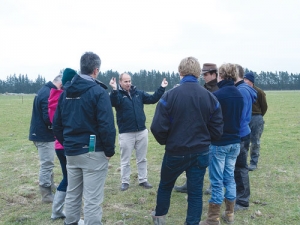Pasture renewal critical to maintaining healthy farms
Pasture renewal is the process of replacing older, less productive pastures with a completely new pasture.
 Agricom’s Allister Moorhead explains the importance of early spring growth to attendees at the recent Marshdale field day.
Agricom’s Allister Moorhead explains the importance of early spring growth to attendees at the recent Marshdale field day.
Early spring growth is an important factor for key animal production systems and farmers can make big differences with forage choices, according to Agricom's Allister Moorhead, product development specialist.
He told the forage company's recent Marshdale field day that this period of growth coincides with two very important spring feed periods.
For a sheep breeding property, pasture cover often declines rapidly at set stocking and there is significant need for growth under increasing stock demand. For a dairy farm, this is near the second grazing round – which influences the date a farmer may reach balance date (supply meeting demand).
Moorhead says this 30-45 day period of growth between mid-September and mid-October can be influenced by traditional ryegrass heading dates. However, this time frame is not always obvious. "Most data on spring growth presented to farmers are means of multiple measurements throughout late winter and spring, often masking the true effect of heading date when they may only influence a 30-40 day period," he explains.
Moorhead highlights how forage choice can affect spring production and refers to Agricom's Easton. Although this is considered a late flowering tall fescue, it is minus 14 Nui. "As an industry we've had mixed messages about spring pasture management. The first seed heads will be out at the start of October which means it been growing 'like stink' throughout September, forcing the early spring growth phase on you."
He says these are very strong spring plants and in cooler environments, as they are putting feed at farmer's feet when traditional rye grass does not.
Moorhead says that in many cases you do not need mid-heading perennials for early spring growth. Mid-heading grasses have reliable September/October growth and produce extra with the onset of seed head development, which drives the 'spring flush'.
This flush is the point in time when extra DM is growing, regardless of climatic conditions. While farm systems are geared to making sure they are capturing this as vegetative (the leafy growth that occurs without the influence of seed head initiation or stem development) and/or quality forage, it is not until farmers get that wrong that the seed head emerges and quality collapses.
Instead, many late heading perennials, which are particularly winter active, can be used to carry cover into August and early September. Moorhead recommends that if farmers are using tall fescue or mid heading ryegrasses, it can be beneficial to have larger areas of later heading genetics to broaden the peak growth period, enabling better pasture management.
He suggests using late heading cultivars, which have a high total production such as Agricom's One (+20) and Prospect (+12). However, he cautions against using all late genetics on farm, suggesting doing so "makes spring pasture management very easy, but may mean in some environments that you do not get a flush of extra growth in September and early October".
Moorheads says Savvy Cocksfoot is relatively late heading and has significant October growth. While it is only considered average during September, by October its growth is 'phenomenal.' By early November it can be just under 400kg ahead of tall fescues.
Although the seed heads of late heading ryegrasses are often slower to emerge – due to being removed during the normal grazing round – the stem has still been created, he warns. This will lead to a post grazing barrier to animals and the residual will build up through November and December. He says this can be worse in unirrigated areas and by January and February this may result in round lengths of 30 days or more.
Whatever a farmer decides, Moorhead suggests that the key to spring management is to start planning early. He recommends aiming for a quick return to grazing through September and October and to defer late heading ryegrass in early October, in favour of quick return on tall fescue or cocksfoot.
He believes it would also be beneficial to consider setting a percentage of tall fescue aside for late October/ early November silage. He adds that while late flowering ryegrasses are still highly attractive in farming systems, it is important to understand what is the most important 'big money' time for a farm.
While the actual potential of vegetative growth lies with the genetics of the cultivar, day length, temperature and nitrogen availability also have huge influence.
Former Agriculture Minister and Otaki farmer Nathan Guy has been appointed New Zealand’s Special Agricultural Trade Envoy (SATE).
Alliance Group has commissioned a new heat pump system at its Mataura processing plant in Southland.
Fonterra has slashed another 50c off its milk price forecast as global milk flows shows no sign of easing.
Meat processors are hopeful that the additional 15% tariff on lamb exports to the US will also come off.
Fears of a serious early drought in Hawke’s Bay have been allayed – for the moment at least.
There was much theatre in the Beehive before the Government's new Resource Management Act (RMA) reform bills were introduced into Parliament last week.

OPINION: The release of the Natural Environment Bill and Planning Bill to replace the Resource Management Act is a red-letter day…
OPINION: Federated Farmers has launched a new campaign, swapping ‘The Twelve Days of Christmas’ for ‘The Twelve Pests of Christmas’ to…